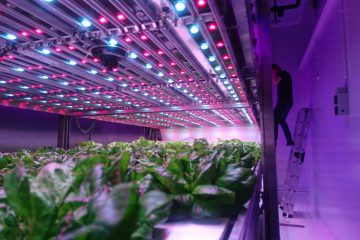Permaculture Practices
Published by Thomas van Rossum on
Permaculture Practices: Learn to Work with Nature
By Delia Rahma
The Green Revolution has changed conventional agricultural practices in all parts of the world by transferring it into mass food production, with high crop yields as a result of heavy irrigation and abundant usage of fertilizers and pesticides. Unfortunately, this excessive use of fertilizer, in the long run, has made soil of poor quality. Fertilizer is also suspected for one of the causes of water pollution. Meanwhile, pesticides also become one of the reasons for the imbalance of ecosystems in nature and are suspected to contain a cancer-triggering element that is one of the main human killer on the planet. The question is, can we increase the productivity of farmers in a more sustainable way? Bill Mollison presented a solution in 1978 with the concept of “permaculture”.
Permaculture is a type of agriculture system which requires design-based process to make the system more sustainable. The aim of permaculture is to restore soil, conserve water, and redirect waste streams [1]. The principle is to make a crop production system by considering the function of each plant and the interaction between plants in which the components inside are mutually beneficial to each other. The process is inspired by everyday relationships found in nature.
Bill Mollison, the “father of permaculture”, defines permaculture as follows;
Permaculture (permanent agriculture) is the conscious design and maintenance of agriculturally productive ecosystems which have the diversity, stability, and resilience of natural ecosystems. It is the harmonious integration of landscape and people providing their food, energy, shelter, and other material and non-material needs in a sustainable way. Without permanent agriculture, there is no possibility of a stable social order. [2]
Permaculture is also a system that can regenerate soil, plants and the ecosystem’s health. Therefore, this system is an organic system, not using any synthetic chemicals. The presence of worms, spiders, birds, bees and other beneficial animals and micro-organisms are expected to be present to support the system’s sustainability. When conventional agriculture uses insecticides to repel pests, the permaculture system will actually invite organisms that are beneficial as natural predators for these insect pests. When conventional agriculture uses herbicides and fungicides, permaculture will actually encourage the growth of weeds and fungi that are useful for growing crops and providing benefits to the field. But it will fight the weeds and fungi un-useful for agricultural purposes in a natural way. Permaculture is about learning to work with nature, not to fight against nature.
An example of the practice of permaculture farming, as explained by Melissa Kruse-Peeples (2016) [3] in her article “How to Grow a Three Sisters Garden”, is to see how “three sisters” interact with each other. One of the most effective “three sisters” is a corn-bean-squash sisterhood. Each of the sisters contributes something to the planting. Corn provides tall stalks for the beans to climb, so that they are not out-competed by sprawling squash vines. Beans provide nitrogen to fertilize the soil while also stabilizing the tall corn during heavy winds. Beans are nitrogen-fixers meaning they host rhizobia on their roots that can take nitrogen, a much-needed plant nutrient, from the air and converts it into forms that can be absorbed by plant roots. The large leaves of squash shade the ground which helps retain soil moisture and prevent weeds. Together, the three sisters provide both sustainable soil fertility.
Another great example of permaculture, is permaculture with a layer system. For example, nine layers are needed for an edible forest garden, namely: 1) Canopy/Tall Tree Layer, 2) Sub-Canopy/Large Shrub Layer, 3) Shrub Layer, 4) Herbaceous Layer, 5) Groundcover/Creeper Layer, 6) Underground Layer, 7) Vertical/Climber Layer, 8) Aquatic/Wetland Layer, and 9) Mycelial/Fungal Layer [4]. Another source says that the edible forest garden just consists of seven layers, that is excluding of the aquatic/wetland layer and mycelial/fungal layer. These layers can benefit each other and form a sustainable ecosystem.
One of permaculture farmers in Indonesia who grows an edible forest garden with the layer system is Misbah Dwiyanto. Together with his wife, Ivana Pratita, he works on a 5-acre land located in Cimahi, a city near Bandung, West Java, and transformed his land into a permaculture farm. They process the harvest together.
On their permaculture farm, there are tall trees such as cherry and mahogany trees as the windbreaker; large shrubs such as lime tree; and medium-sized shrubs such as rosella tree. They grow long beans, soybeans, and green beans as nitrogen suppliers and they are planted near vegetable crops. They do not wipe the dry leaves and let the grass and weeds grow on the ground in order to be useful as mulch. They also have a pond for processing greywater as well as for farm irrigation, and the pond is planted with water hyacinth to absorb toxins in the water. For pest control, they apply several strategies: planting Allium genus plants near the solanum crops (tomatoes, potatoes) to get rid of pests such as snails or aphids; and planting sunflowers, frangipani flowers, also spreading lots of mint leaves, to become the decoy for birds and insects control, so that the birds and insects do not attack the fruit and vegetable.


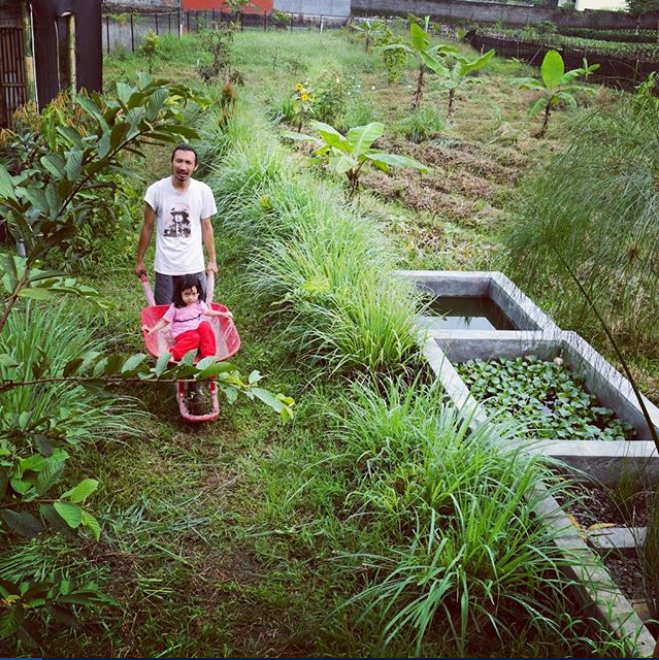
While the Green Revolution increased wheat and rice yields, it also cut back on other food sources. Much of the vegetables were grown at the edges of the paddy field, but were often replaced for rice production. Ironically, ‘more rice’ meant ‘worse nutrition’. Not only vegetables, but also other protein-rich food was replaced, leading to a decline of Vitamin A intake. From the aspect of crop yield, products from permaculture can actually not be compared apple to apple with conventional agriculture.
A conventional apple orchard will, of course, have a higher yield of apples per apple tree when compared to apple trees on permaculture farms. There may be some grass growing under the trees, but nothing else. However, in a permaculture garden, near the apple trees, there are maybe strawberries or blackberries or culinary herbs or mushrooms herbs, maybe all of them together. The apple tree may decrease its yield by up to 50% due to some competition of soil or nutrients, but all the other fruits, nuts, herbs, etc. will increase total yields of that area to more than a single-crop system can ever consider [4].
As Astyk (2007) has mentioned in her article that Peter Rosset has documented that from the eye of industrial agriculture, when five acres of soybeans and 5000 acres of soybeans are compared, you get more soybeans per acre by growing 5000 acres. But when you compare the output – you will get more food, fertility and fiber from a small-scale-polyculture farm, and the five acre polyculture farm comes out vastly ahead in per acre nutrition output [5].
The amazing output is also experienced by Luky Lambang Santoso. In Rumah Kayu Permaculture, a relatively small-sized permaculture farm (about 3,3 acre) owned by Kang Luky (Luky’s nickname) located in Cisarua, West Bandung, West Java, he plants various crops including rice, grains, fruit and vegetables organically. The crop yield makes the family’s diet more nutritious and healthier. In fact, the diet can relieve the lupus suffered by Kang Luky and the cyst suffered by his wife. “Permaculture is our effort to survive,” said Kang Luky. For him, permaculture is seen as their family way of life, the true wealth, more than money can give.
Kang Luky grows his permaculture farm relying on its sustainability, where ecological principles become the main standard for the living web in his garden. Kang Luky raises chickens, ducks and fish, which will become the agents to process the garden waste. From the garden, high quality vegetables will be sold, and low quality vegetables will be chopped, added high-protein plants such as indigofera, and given to chicken, duck and fish as the feed. The nutritious pond water is used to water the crops. In addition, as the nutrient for the garden, Kang Luky also plants nitrogen, phosphorus, and potassium binding plants, such as the Mexican sunflower which can bind those elements together. Kang Luky grows tall trees at the western end of the garden. The more eastward, the shorter the plant. This is done this way, so that the large trees shade the vegetables from the afternoon sun.
He started his permaculture farm with several problems such as; difficult access to water and infertile soil. During the first years, his farm soil gradually improved due to the planting of diverse and nutrient-rich crops. Hence, it can be seen that permaculture farming is very appropriate to be applied in unproductive land. Marginal land can be used, by regenerating it first with nutrient binding plants.

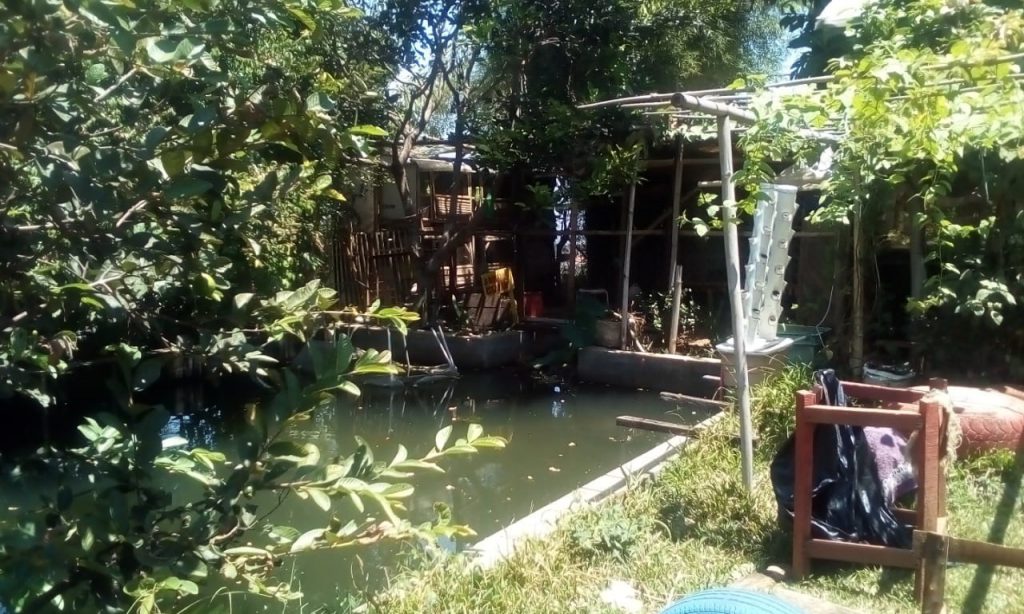

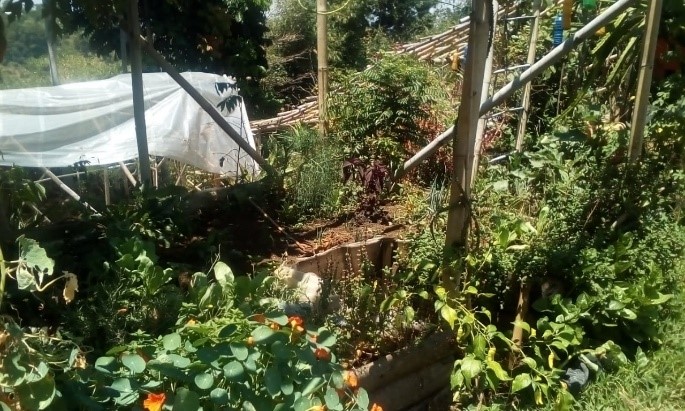
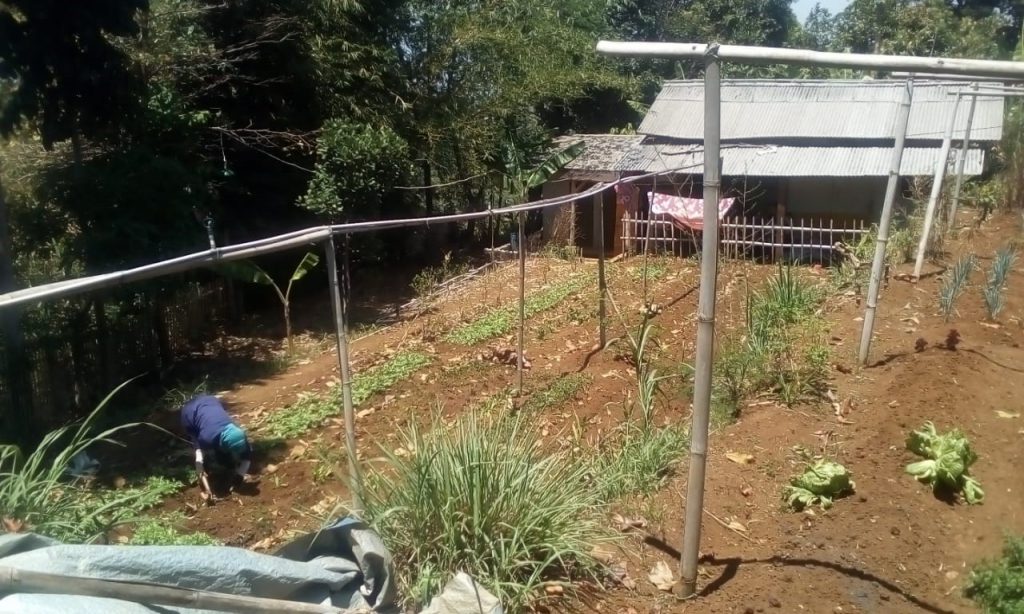
The question now is: How to encourage more farmers to farm with permaculture system? “Nowadays, many Indonesians have adopted a healthy lifestyle. Therefore, organic or sustainable farming is requested. Especially for people with severe illnesses like me, ” said Kang Luky. Kang Luky believes that to encourage farmers to plant with permaculture system, they have to be educated first on the importance of producing organic food. They will be more concerned about growing organic crops if the demand comes from the market. On the other hand, the challenge usually comes from the government. “The field agricultural extension officers from the government sometimes go to the villages to provide education for farmers on how to plant crops organically, but the farmers are always obscured by the fact that the officers at the same time also bring and sell chemical fertilizers cheaply from the factory. The officers get commissions from the sale. It makes it even more difficult for the farmers to start planting organically,” explained Kang Luky again. The incentive to grow more sustainably will disappear as soon as it came. Not to mention that supplying organic fruit and vegetable to supermarkets are really costly in Indonesia, because of the cost of organic food certificates, which is about 35 million Rupiah (at the minimum rate). “Farmers here already have a mindset that in order to fulfill basic needs, you have to make money, instead of planting your own needs.”
A much heard opinion in today’s society is that permaculture system is not suitable for modern farmers since it makes less money than a conventional system; it is more suitable for subsistence farmers (subsistence farmers are those who focus on growing enough food to feed themselves and their entire family, then selling the surplus); and it will only feed the people who own it – it will not be enough to feed everyone, especially in a country with very densed population and high food demand like Indonesia. Although these concerns should be taken into account, it could not be underestimated that Kang Luky has been managing to sell 50% of his harvest while the family’s necessity has been almost 100% fulfilled. It has never been a problem to sell his different variety of harvest to the market. Even better, he has been able to stabilize his income by producing different crops, overcoming problems like price fluctuations.
One of the recommended tool to implement permaculture farming in the society is by launching and utilizing the Community Supported Agriculture (CSA). Community Supported Agriculture consists of a community of individuals who pledge support to a farm operation so that the farmland becomes, either legally or spiritually, the community’s farm, with the growers and consumers providing mutual support and benefits of food production [6]. Although, CSA is perhaps not the perfect solution for highly densed urban areas, for people living in difficult or disconnected areas, people around marginal land, or people in areas which are in the process of recovery from disasters, permaculture can be a solution to maintain food security, even food sovereignty.
The challenges faced by Indonesian farmers, such as fluctuation of food prices, the existence of middlemen in the food supply chain, unproductive soil conditions due to excessive fertilizer usage, and dry weather during the dry season – can gradually be overcome by permaculture farming. It’s not just that permaculture can overcome those problems, permaculture also brings bigger opportunity of providing enough high-nutrient food for the community. Instead of growing single crops, multi-cropping is encouraged in permaculture farming. An increase in total crop yield on a permaculture farm, means more output and more nutrition. Therefore, permaculture can be a solution to farmers in growing method to overcome hunger and build food independence for people in many regions in Indonesia.
Many farmers in Indonesia are accustomed to the abundant use of fertilizers and pesticides, leaving chemical residues in crops and contributing negative impacts to the environment. Permaculture concept offers ecosystem design that utilizes the agro-ecological principles. So when ecosystem interactions are already in place and form a cycle, fertilizer and pesticides can be highly reduced.
At Agrodite, we want to demonstrate and train farmers on integrated sustainable farming systems, including permaculture. Thus, farmers who are afraid to adjust their farming style to a new system due to the risks, will be assisted and trained by Agrodite. With Agrodite, farmers can be more comfortable to adjust their-selves and their systems by a step by step approach.
Back to the first question in this article: can we increase the productivity of farmers in a more sustainable way? Yes, absolutely, it’s really possible, and one of the methods is permaculture. Permaculture farming is a system that is environmentally friendly, supports the balance of ecosystems, and can produce crops from various commodities that are safer and more nutritious. Whereas food self-sufficiency in the green revolution was a false success, it’s not impossible to turn the current agricultural pattern into the era before the green revolution, where agriculture generates great amounts of nutrition, preserves biodiversity, maintains the natural food chain, conserves local food, and – of course – functions sustainably.
This article is written by:
Delia Rahma: Bio-Engineering expert with a degree from Institut Teknologi Bandung, with a passion for organic agriculture.
For more information: www.agrodite.com
Reference:
[1] Nierenberg, Danielle. 2015. 16 Successful Projects Highlighting Permaculture Use [online]. Retrieved from https://foodtank.com/news/2015/07/sixteen-successful-projects-highlighting-permaculture-use/.
[2] Mollison, Bill. 2002. Permaculture: A Designers’ Manual. Tasmania, Australia: Tagar Publications.
[3] Kruse-Peeples, Melissa. 2016. How to Grow A Three Sisters Garden [online]. Retrieved from https://www.nativeseeds.org/learn/nss-blog/415-3sisters.
[4] Kitsteiner, John. 2016. Permaculture Basics: Edible Forest Gardens [online]. Retrieved from http://tcpermaculture.com/site/?s=edible+forest+garden.
[5] Astyk, Sharon. 2007. How Much Did The Green Revolution Matter? Or Can We Feed The World Without Industrial Agriculture? [online]. Retrieved from https://www.resilience.org/stories/2007-01-29/how-much-did-green-revolution-matter-or-can-we-feed-world-without-industrial-agri/.
[6] U.S. Department of Agriculture. 2018. Community Supported Agriculture [online]. Retrieved from https://www.nal.usda.gov/afsic/community-supported-agriculture.
